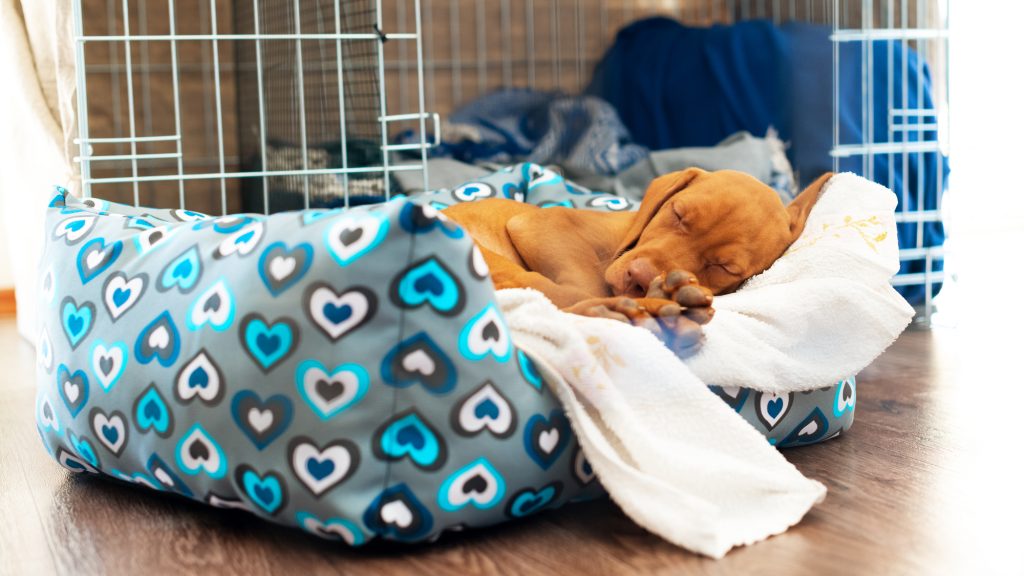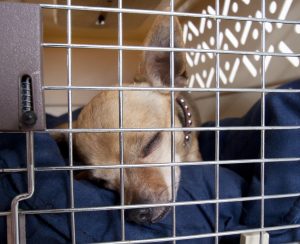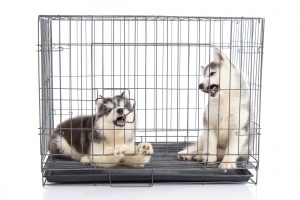 Crate training – these words can strike fear into the heart of even the sturdiest dog owner. But it doesn’t have to be a difficult task. With the right steps, even the most reluctant pooch can learn to love their crate home.
Crate training – these words can strike fear into the heart of even the sturdiest dog owner. But it doesn’t have to be a difficult task. With the right steps, even the most reluctant pooch can learn to love their crate home.
Here are five things you should consider when training your puppy.
Tip #1. Picking the Right Crate Makes All the Difference
There are several types of crates out there, including soft-sided, wired, furniture (or fashion crates), and plastic carriers. The best option for you depends on whether you want a crate you can move around, how much money you want to spend, and where you plan to keep it.
-
 Wire crates are nice because they can fold down and be stored away. They also provide lots of air circulation, and you can see what your dog is up to. You can also cover them when you want to provide your dog with some privacy. Most of them come with dividers, which is nice since your puppy is still growing. Finally, they’re pretty easy to clean since they usually have a plastic tray for the base that you can slide in and out. That comes in handy when it’s time to clean up an accident.
Wire crates are nice because they can fold down and be stored away. They also provide lots of air circulation, and you can see what your dog is up to. You can also cover them when you want to provide your dog with some privacy. Most of them come with dividers, which is nice since your puppy is still growing. Finally, they’re pretty easy to clean since they usually have a plastic tray for the base that you can slide in and out. That comes in handy when it’s time to clean up an accident. - Furniture crates are ideal if you want to keep it in your living room, but you don’t want the look of the crate ruining your decor. They can be expensive, though, and if your dog is chewer, the wood might make a tempting target to sink their teeth into.
- Plastic crates give your dog a sense of being snuggled up in a cave, which some canines appreciate. Other dogs don’t like the limited visibility. They can also be a pain to move around and clean.
- Soft-sided crates aren’t the best choice for leaving your dog alone for longer periods. They work fine while traveling, but a dedicated chewer or scratcher can make quick work of the fabric and may be able to escape.
You also need to select the right size for your dog. Too big, and your dog may decide that the back corner is the perfect spot to go potty. Too small, and they’ll be uncomfortable while you’re gone.
To determine the right size, pick something that your dog can stand up and turn around in, but not so big that they can move from one area to another.
Tip #2. Know What to Put Inside Your Puppy’s Crate
Perhaps the most essential element of crate training a puppy is to teach them to love their home. No one wants their new dog to be miserable and think of the crate as being punished and locked up.
This can take some time, but it’s worth the effort. First, fill it with things that will make your pup comfy.
A chew toy and a few blankets, even a heated bed or pad, will encourage your fido to see that the crate is a fun and a relaxing spot. If your dog is particularly focused on you, add an old shirt of yours. This is a good trick for those pets who tend to have separation anxiety.
Take a look at how this paw parent set-up her doggo’s crate so it can be comfy:
Then, leave the door open and toss her favorite snack inside every now and then. Let your puppy explore the crate on their own time.
Praise or give your four-legged buddy a treat every time she goes inside or even check out the crate without showing any fear.
It may take a few hours, or it may take a few days, but eventually, she should be stepping inside and curling up for a nap all on her own.
If you want to give your pup plenty of time to get familiar with her crate without leaving her the run of the house, you could put the crate inside a puppy playpen.
Once they’re comfortable entering the crate, start feeding them inside. This reinforces that it is a happy place full of good things.
Your canine friend will learn that the crate is her personal space that she can retreat to anytime she wants.
Tip #3. Nail the Timing
When it comes time to close the door, timing is everything. If your pup doesn’t seem comfortable in her crate yet, and you close the door on her, expect your pooch to freak out.
This can be avoided by waiting until you’re sure that she’s comfortable and then close the door and praise her – but stay right there!
After a few seconds, open the crate door and calmly let your pup out. If you want, you can reward her BEFORE she steps outside. You don’t want to treat your pet after because she may see that leaving the crate is a good thing.
Gradually extend the time that you keep the door closed. If your dog seems to get anxious, you’ve kept it shut for too long. Back up and start over.
Next, it’s time to step away from the crate with the door closed. Again – timing is key! Close the door with your pup inside, step out of the room for a second, then return and wait a moment outside the door until they’re calm. Now you can open the door without fanfare.
Little by little, increase the time you’re away from the crate until your puppy can handle at least an hour being inside without you in sight. If your dog has an accident in the crate, you probably left them alone for too long (or they have too much space). Take a deep breath and go back to the first step.
A dog under six months shouldn’t be left alone for longer than three or four hours. For every month of age, your puppy can hold its bladder for about an hour. You also shouldn’t even start crate training until a puppy is over eight weeks old.
Tip #4. Always Be Positive
Nothing will derail crate training faster than a negative experience. If you shout at, scold, or smack your puppy, not only will they learn to associate the crate with bad things, but they may learn not to trust you.
Your dog is going to make mistakes. She might have an accident, start howling, or she might try to bite at the door to get out. No matter what, stay positive and reinforce good behavior. Don’t tolerate bad behavior, but don’t punish your little furball, either.
 If you really want to encourage your dog to love her crate, make it a place where you give her extra special attention or play a game. For instance, if your dog loves a particular ball, toss it in the crate while playing fetch.
If you really want to encourage your dog to love her crate, make it a place where you give her extra special attention or play a game. For instance, if your dog loves a particular ball, toss it in the crate while playing fetch.
You should also never use the crate as a punishment. If your puppy has an accident, don’t put her in the crate and scold her. Reserve the crate for fun and relaxation only.
Tip #5. Exercise Is Key!
If you want your fur baby to have a positive crate experience, she absolutely must be able to get her energy out before going into the crate.
Puppies don’t require a ton of exercise, but every owner should have a daily schedule for play time. It can be as simple as taking a short trip around the yard, or whatever it takes before putting her in the crate. This will make your job so much easier.
Instead of being wound up or anxious, your puppy will be so pooped that she’ll probably fall right asleep. After all, “a tired dog is a happy dog.”
You’ll know you did this crate training thing right if she begins to see the crate as a place to escape and nap.
When your pup stops playing with you and runs off to her crate to take a breather, give yourself a pat for a job well done!
Crate Training a Puppy Doesn’t Have to Be a Burden
We’ve all heard the horror stories of training puppies, and that includes crate training, but it doesn’t have to be such a chore.
NEVER use the crate to keep your canine buddy in isolation or to keep her locked up throughout the day. It should serve as your pup’s home or safe space.
This type of training is definitely helpful to avoid chaos whenever you’re not home, but anyone will have trouble staying cooped up in a very small area.
You don’t have to be a professional trainer or to hire one for you and your pup to accomplish crate training. Just remember three key things: patience, positivity… and more patience!
What’s your experience with crate training your puppy? Do you have any tips? Let us know by commenting below.










